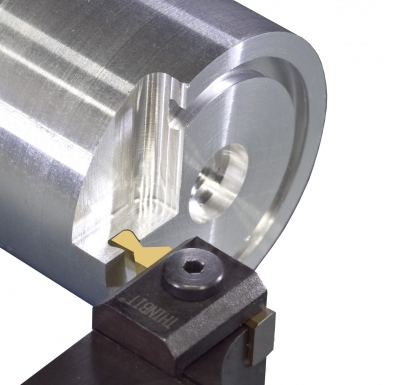
THINBIT, manufactured by Kaiser Tool Co., announces the expansion of its GROOVE ’N TURN line of dovetail grooving inserts. Dovetail grooving inserts are used to machine O-ring dovetail grooves with 66° undercut angles. The insert design is optimized for strength by utilizing an insert pair to generate the groove form. Insert sizes are .030”, .050, .060, .070”, .080, .090”, .100”, .125” and .150” with major diameters starting at .300”.
Available in submicron-grain carbide grades for ferrous and nonferrous materials either uncoated or with TiN, TiCN, TiAIN or diamond film coatings. GROOVE ’N TURN dovetail inserts can be used on conventional, Swiss and CNC machines.
Toolholders are available in square shank size 5/16” through 1-1/4” and round shank sizes ½” through 1” with straight and 90° presentations. GROOVE ’N TURN dovetail inserts fit existing “L” series THINBIT toolholders.
Contact Details
Related Glossary Terms
- computer numerical control ( CNC)
computer numerical control ( CNC)
Microprocessor-based controller dedicated to a machine tool that permits the creation or modification of parts. Programmed numerical control activates the machine’s servos and spindle drives and controls the various machining operations. See DNC, direct numerical control; NC, numerical control.
- grooving
grooving
Machining grooves and shallow channels. Example: grooving ball-bearing raceways. Typically performed by tools that are capable of light cuts at high feed rates. Imparts high-quality finish.
- shank
shank
Main body of a tool; the portion of a drill or similar end-held tool that fits into a collet, chuck or similar mounting device.
- titanium carbonitride ( TiCN)
titanium carbonitride ( TiCN)
Often used as a tool coating. See coated tools.
- titanium nitride ( TiN)
titanium nitride ( TiN)
Added to titanium-carbide tooling to permit machining of hard metals at high speeds. Also used as a tool coating. See coated tools.
- undercut
undercut
In numerical-control applications, a cut shorter than the programmed cut resulting after a command change in direction. Also a condition in generated gear teeth when any part of the fillet curve lies inside of a line drawn tangent to the working profile at its point of juncture with the fillet. Undercut may be deliberately introduced to facilitate finishing operations, as in preshaving.






